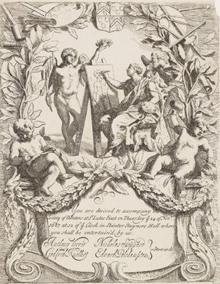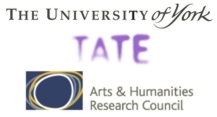One-day Conference: Court, Country, City: British Art 1660-1735
Revisiting British Art 1660-1735
7th May 2010 at the Berrick Saul Building, University of York Heslington Campus
Speakers
Tabitha Barber (Tate Britain), Katherine Coombs (V&A), Diana Dethloff (UCL), Karen Hearn (Tate Britain), Richard Johns (National Maritime Museum), Catharine MacLeod (National Portrait Gallery)
This conference is designed to open up new perspectives on a fascinating, important but under-studied era of British art. Between 1661, when Peter Lely was installed as court painter to the newly restored king, Charles II, and the mid-1730s, when the St Martin’s Lane Academy established itself as London’s dominant artistic forum, British art was in a state of continual flux. Established patterns of patronage and practice, linked in particular to the cultural spheres of the court and the aristocratic house, were being challenged by those associated with a burgeoning urban art world, centred in the English capital, but also encompassing national and regional centres such as Edinburgh, Norwich and York. The British art world was also being transformed by the traffic of artists, objects, texts and concepts across both global and national networks in this period, which helped shape a strikingly cosmopolitan and multi-faceted visual culture, populated by a rich mixture of foreign-born and local artists and ideas. ‘Revisiting British Art 1660-1735’ will showcase the latest scholarship on this dynamic period in the history of British art, and seek to identify promising directions in which research on this topic might move forward.
This is the first of a series of major scholarly events hosted by the AHRC-supported research project ‘Court, Country, City: British Art 1660-1735’. This three-year project (October 2009-September 2012), which is led by Professor Mark Hallett of the University of York and Professor Nigel Llewellyn and Dr Martin Myrone of Tate Britain, is designed to offer an original, scholarly and compelling history of the visual arts in Britain between 1660 and 1735. The project aims to highlight the crucial importance of this era within the longer history of British art, and place artistic practice, display and consumption in the context of the wider historical changes that were taking place within the nation as a whole.
The Conference will take place in the Berwick Saul Building at the University of York.
Printer-friendly programme and abstracts programme and abstracts 2010 conf (MS Word ![]() , 45kb)
, 45kb)
PROGRAMME
9.00 Registration and coffee
9.40 Mark Hallett (University of York)
Introduction: ‘Court, Country, City’: why we need to look anew at British Art 1660-1735
10.00 Karen Hearn (Tate Britain)
"Nearly all the most famous artists left England"?: exile and return on the part of mid-17th-century painters and clients
10.45 Tabitha Barber (Tate Britain)
Mary Somerset, Duchess of Beaufort (1630-1715) and the culture of collecting
11.30 Coffee
11.45 Katherine Coombs (V&A)
'Miniature or limning viz the diminutive kind': A consideration of miniature painting 1660 to 1735
12.30 Round Table Responses 1: Martin Myrone (Tate Britain – Chair) and Sarah Monks (University of East Anglia)
1.15 Lunch
2.00 Diana Dethloff (University College London)
Lely's 'academy': London artists and the practice of drawing, c.1655-1680
2.45 Catharine MacLeod (National Portrait Gallery)
The Lely product: portraiture and the artist’s studio in Restoration England
3.30 Tea
3.45 Richard Johns (National Maritime Musuem)
‘Those wilder sorts of Painting’: the painted interior in the age of Antonio Verrio
4.30 Round Table Responses 2: Nigel Llewellyn (Tate Britain – Chair), Mark Jenner (University of York) and Jason Edwards (University of York)
5.15 End of conference
ABSTRACT OF PAPERS
TABITHA BARBER
Tate Britain
Paper title: Mary Somerset, Duchess of Beaufort (1630-1715) and the culture of collecting
Paper abstract: By the 1680s the Duke and Duchess of Beaufort were said to have adopted a 'princely way of living' which they used 'above any other, except crowned heads'. The remodelled Badminton, Gloucestershire, and Beaufort House, Chelsea, were luxuriously furnished by the Duchess, whose constant acquisitions are recorded in surviving documents. This deliberate display of magnificence coexisted on Mary Somerset's part with a sophisticated interest in botany: she was one of the most important collectors of exotic plants of her day. The size and significance of her botanical collections at Badminton and Cheslea, where species from around the world were cultivated in England for the first time, brought her into contact with foremost botanists such as John Ray, James Petiver, William Sherard and Sir Hans Sloane, to whom she bequeathed her twelve-volume herbarium. Using Mary Somerset as a case-study, this paper will investigate the relationship between aristocratic collecting and the philosophical principles governing the collections of contemporary scientific virtuosi. Doing so will usefully call into question some of our assumptions regarding the character and extent of aristocratic collecting in this period.
KATHERINE COOMBS
Victoria and Albert Museum
Paper title: 'Miniature or limning viz the diminutive kind'*: A consideration of miniature painting 1660 to 1735.
[* The Third Earl of Shaftesbury c.1712]
Paper abstract: Shaftesbury noted of 'miniature or limning' that, for portraiture, 'convenience and use renders [it] agreeable and friendship amiable'. I will offer an overview from 1660 to 1735 of an art properly defined by its medium (watercolour), rather than its size ('diminutive'). I will consider how the size of miniatures and their functionality, both noted by Shaftesbury, have circumscribed analysis of 'limning' at this time.The period from Samuel Cooper's death in 1672 to the 1740s has been characterised as one of decline for a once high status art form; the introduction of ivory in place of vellum as painting support c.1705 a convenient hiatus. Indeed, David Piper dismissed early 18th century miniatures as 'little Knellers, Jervases, and Hudsons'. I will suggest other contexts and relationships which allow for more nuanced readings of the miniature, and question the habitual dismissal of the genre as one operating on the margins of visual culture.
DIANA DETHLOFF
University College London
Paper title: Lely's 'academy': London artists and the practice of drawing, c.1655 - 1680
Paper abstract: In many European academies and studios, drawing was a fundamental part of the training of artists, whereas in Britain during this period, as is well known, there was no officially recognised system in place. In my paper, based on a surviving sketchbook and other seventeenth-century British drawings and manuscript sources, I will suggest that in one studio at least, that of Peter Lely, the study and practice of drawing was actively and pedagogically promoted. I will consider what was drawn; what possible sources and models were used; what this reveals about studio practice in Restoration London and whether the contemporary references to Lely's 'academy' as a place of training and learning can be justified. Such an analysis will allow us to redefine the relationship between drawing and portraiture in the period, and open up new perspectives on the history of artistic education in London before the establishment of Kneller’s celebrated Great Queen Street Academy in the early eighteenth century.
KAREN HEARN
Tate Britain
Paper title: '"Nearly all the most famous artists left England"?: exile and return on the part of mid-17th-century painters and clients
Paper abstract: Focusing on elite portrait-painting, I shall briefly consider the market for portraits in Britain in the two decades up to the Restoration, before looking at those British artists who went into Continental exile: who they were, where they went, and whether they came back by, or at, the Restoration. I will also attend to British sitters and clients in exile, and the extent to which they chose to be painted by local portraitists or by fellow-exile artists who offered them a familiar 'product' in an unfamiliar environment. Finally, I shall briefly consider the patronage choices these clients made on their return to Britain following the Restoration. Such an analysis will allow a new conceptualisation of the state of British portraiture at the beginning of the period covered by the ‘Court, Country, City’ project, and provide the means with which to gauge the continuities and contrasts it exhibited when compared with the state of portraiture before the accession of Charles II.
RICHARD JOHNS
National Maritime Museum
Paper title: ‘Those wilder sorts of Painting’: the painted interior in the age of Antonio Verrio
Paper abstract: During the later seventeenth and early eighteenth centuries, the scenographic decoration of walls and ceilings, typically incorporating subjects from classical history or mythology, became one of the most prestigious forms of art in England. The rise of grand-scale decorative history painting was largely a result of the career at the Restoration court of the Neapolitan artist Antonio Verrio, and of the subsequent successes of a generation of artists that followed him. In modern times, these artists and the work they produced represent one of the least-studied of all episodes in the history of British art. This paper reflects on the rise and fall of the painted interior. In doing so, it considers how the prevailing discourse of British art history has shaped the ways in which the work of Verrio and those who made a name for themselves working in a similar idiom has been regarded and – more commonly - disregarded.
CATHARINE MACLEOD
National Portrait Gallery
Paper title: The Lely product: portraiture and the artist’s studio in Restoration England
Paper abstract: With a rapidly growing demand for portraits in late seventeenth-century Britain, the organisation and management of an extensive studio became an increasingly important aspect of the successful artist’s business. The studio of Peter Lely is the earliest in Britain for which a substantial body of evidence survives. Bringing together material from a wide range of sources, this paper examines what can be known about Lely’s studio practice, including the process of making portraits; the division of labour among those working in the studio; and other related activities in the studio. It considers the impact of Lely’s studio practice not only on his own portraiture, but also on the wider practice of British art in the late seventeenth century. In so doing this paper will raise questions about the relationships between clients' expectations, conventional discourses on portraiture and the demands of commercial production for a rapidly expanding art market.


